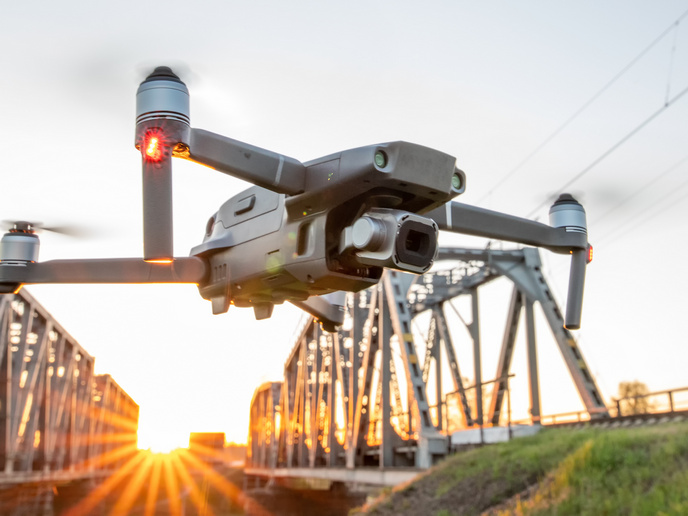
Currently, railway and bridge inspections in Europe rely on humans who carry out their work on foot or by helicopter. This presents limitations in terms of safety, costs, and accuracy. To address these challenges, industrial and research experts in infrastructure inspection, energy harvesting, artificial intelligence, communications, and drone technology joined forces in the EU-funded project Drones4Safety. Their objective was to develop a cooperative, autonomous, and continuously operating drone system that could be used by transport operators. “The Drones4Safety technology promises to revolutionise the inspection process, making it more efficient and less reliant on human resources,” asserts Emad Samuel Malki Ebeid, Drones4Safety project coordinator from the University of Southern Denmark.
Features of the drone system
Powered by AI, the Drones4Safety system includes capabilities of autonomous flight and self-charging, the ability to operate in swarms, and the detection of faults. The main challenges of the project were tackled with advanced mmWave technologies for enhanced sensing capabilities, multiprocessor systems on chips for processing-intensive tasks, and the design of a robust Faraday cage for protecting drones from electromagnetic interference.
Energy harvesting solution
The drones are not only capable of autonomous flight but also of self-recharging using railway and power line cables. When a drone’s battery level is low, it autonomously navigates to the nearest overhead line. This navigation is guided by cloud-based AI software and signals from Global Navigation Satellite Systems (GNSS) and the European Geostationary Navigation Overlay System (EGNOS).
“These drones are equipped with onboard navigation systems that utilise sensors to detect and locate the power lines, allowing them to travel toward the active line for recharging,” explains Ebeid.
The researchers needed to design a method for the vehicles to connect to such a power source. Project partners Fraunhofer and NEAT developed two mechanisms to recharge from AC and DC lines. The AC harvester works based on the induction concept, leveraging the oscillating magnetic field of the power lines. The DC harvester, which fits well into the railway system, converts the DC line voltage level to the drone voltage level using fast switching and heat dissipation methods.
Swarm system
The algorithms for swarm operation are new to the drone sector. The goal was to delegate tasks among multiple drones, improving inspection efficiency through a common information-sharing and synchronisation setup. Drones4Safety successfully developed swarm algorithms focused on path planning and formation flying, which also include obstacle and collision avoidance, as well as protection against cybersecurity threats.
Detection of faults powered by AI
AI plays a big part in the project: the images captured by the drones are transmitted to a cloud server, where trained algorithms detect any infrastructure defect during the inspection. The AI software provider Alteia oversaw the development of the AI algorithms, having trained them with pictures of faults found in railways and bridges within a real-world environment. The Drones4Safety system was tested at the Asti Bridge in Italy, in collaboration with project partner Eucentre, and at the Siemens Railway Test Centre in Germany, with the support of ARIC. The project will launch a start-up to offer the solution as a service to the market.
MORE INFORMATION
CORDIS project factsheet: Drones4Safety
This article was originally published in © CORDIS - EU Research Results
- Reference
- SOCIETAL CHALLENGES - Smart, Green And Integrated Transport
- Project duration
- 1 Jun 2020 - 31 May 2023
- Project locations
- DenmarkBelgiumFranceGermanyItaly
- Overall budget
- €3 733 751
- EU contribution
- €3 533 19394.6% of the overall budget
- Project website
- https://drones4safety.eu/
